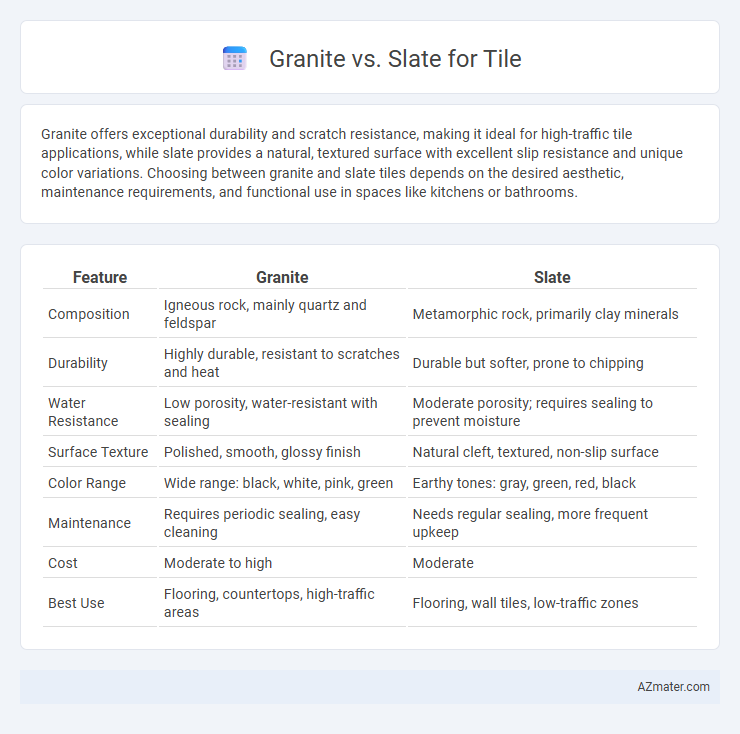Granite offers exceptional durability and scratch resistance, making it ideal for high-traffic tile applications, while slate provides a natural, textured surface with excellent slip resistance and unique color variations. Choosing between granite and slate tiles depends on the desired aesthetic, maintenance requirements, and functional use in spaces like kitchens or bathrooms.
Table of Comparison
| Feature | Granite | Slate |
|---|---|---|
| Composition | Igneous rock, mainly quartz and feldspar | Metamorphic rock, primarily clay minerals |
| Durability | Highly durable, resistant to scratches and heat | Durable but softer, prone to chipping |
| Water Resistance | Low porosity, water-resistant with sealing | Moderate porosity; requires sealing to prevent moisture |
| Surface Texture | Polished, smooth, glossy finish | Natural cleft, textured, non-slip surface |
| Color Range | Wide range: black, white, pink, green | Earthy tones: gray, green, red, black |
| Maintenance | Requires periodic sealing, easy cleaning | Needs regular sealing, more frequent upkeep |
| Cost | Moderate to high | Moderate |
| Best Use | Flooring, countertops, high-traffic areas | Flooring, wall tiles, low-traffic zones |
Introduction to Granite and Slate Tiles
Granite tiles, formed from coarse-grained igneous rock, are highly durable and resistant to scratches, making them ideal for high-traffic areas and outdoor applications. Slate tiles, derived from fine-grained metamorphic rock, offer a natural cleft texture and excellent slip-resistance, commonly used in bathrooms and patios for aesthetic appeal and functionality. Both materials provide unique visual characteristics and longevity, with granite showcasing vibrant mineral patterns and slate presenting earthy, layered tones.
Key Differences Between Granite and Slate
Granite is a durable, igneous rock known for its speckled appearance and high resistance to heat and scratching, making it ideal for heavy-traffic areas. Slate, a metamorphic rock, offers a fine-grained texture with natural cleft surfaces that provide excellent slip resistance and a more rustic, earthy aesthetic. Key differences include granite's superior hardness and polish capability versus slate's unique layering and slightly softer composition, influencing maintenance and application in tile projects.
Appearance and Aesthetic Appeal
Granite tiles showcase a natural, speckled pattern with a polished surface that enhances light reflection, offering a luxurious and timeless aesthetic. Slate tiles provide a matte, textured look with subtle color variations ranging from gray to black, lending a rustic and earthy charm to spaces. While granite suits modern, high-gloss designs, slate complements organic, natural interiors with its unique, uneven finish.
Durability and Lifespan Comparison
Granite tiles offer exceptional durability due to their high density and resistance to scratches, heat, and stains, making them ideal for high-traffic areas with a lifespan exceeding 50 years when properly maintained. Slate tiles, while slightly softer, provide strong durability with natural cleavage planes that make them slip-resistant and durable for up to 40 years, especially suited for outdoor and wet environments. Both materials require periodic sealing to maintain longevity, but granite typically outlasts slate in terms of hardness and resistance to wear.
Water and Stain Resistance
Granite tiles exhibit exceptional water resistance due to their dense, non-porous surface, making them highly durable against moisture absorption and staining. Slate tiles, while moderately water-resistant, are more porous and can absorb liquids if not properly sealed, increasing their vulnerability to stains and water damage. Regular sealing enhances the stain resistance of both materials, but granite consistently offers superior performance in wet environments and for stain prevention.
Installation Process and Complexity
Granite tiles require precise cutting and professional-grade tools due to their hardness and density, making the installation process more labor-intensive and time-consuming compared to slate. Slate tiles are softer and more pliable, allowing for easier cutting and shaping, which reduces installation complexity and labor costs. Both materials demand a level surface and proper sealing, but granite's weight and brittleness necessitate a more meticulous handling approach to prevent cracks during installation.
Maintenance Requirements for Granite vs Slate
Granite tiles require minimal maintenance due to their high resistance to scratches, stains, and moisture, often needing only periodic sealing to maintain their durability. Slate tiles demand more frequent sealing to prevent water absorption and staining, and they may require specialized cleaners to preserve their natural texture and color. Both materials benefit from regular cleaning, but slate's porous nature makes ongoing maintenance more intensive compared to the dense, non-porous surface of granite.
Cost Analysis: Granite Tiles vs Slate Tiles
Granite tiles typically cost between $5 and $10 per square foot, offering durability and a polished aesthetic ideal for high-traffic areas. Slate tiles range from $4 to $9 per square foot, providing a natural, textured surface with excellent slip resistance, often preferred for outdoor or rustic designs. Both materials require similar installation costs, but granite generally demands higher maintenance expenses due to sealing requirements compared to the relatively low upkeep slate demands.
Best Applications for Each Material
Granite tiles excel in high-traffic areas such as kitchens and entryways due to their exceptional durability, resistance to scratches, and ability to withstand moisture and heat. Slate tiles are ideal for outdoor patios, bathrooms, and fireplaces, offering excellent slip resistance and natural cleft textures that enhance traction and aesthetic appeal. Both materials perform well in flooring and wall applications, but granite's hardness suits commercial spaces while slate's unique layering is perfect for rustic or textured designs.
Pros and Cons of Granite and Slate Tiles
Granite tiles offer exceptional durability and resistance to scratches and heat, making them ideal for high-traffic areas and kitchen surfaces, but they can be more expensive and require periodic sealing to maintain their appearance. Slate tiles provide a natural, textured look with excellent slip resistance and low porosity, reducing water absorption; however, slate is softer and more prone to chipping and requires regular maintenance to prevent staining. Choosing between granite and slate depends on balancing the need for robust, long-lasting surfaces against the desire for distinctive, rustic aesthetics and ease of upkeep.

Infographic: Granite vs Slate for Tile
 azmater.com
azmater.com